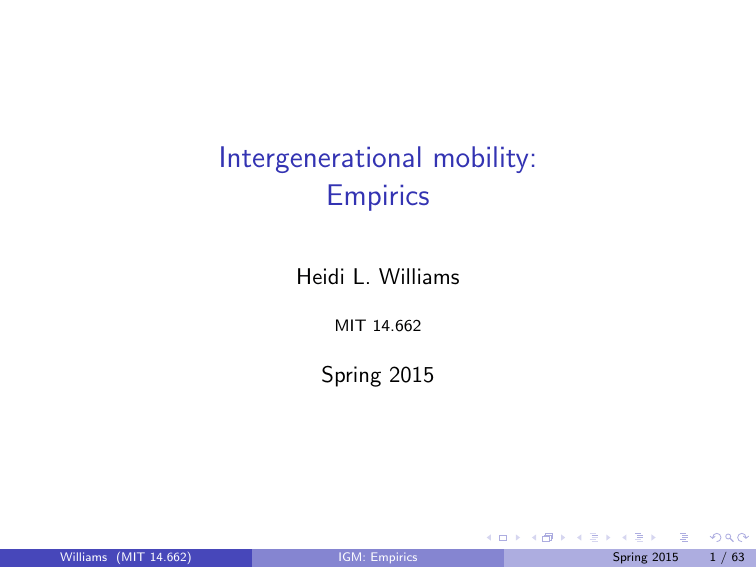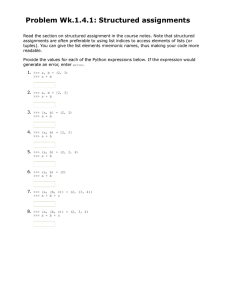
Intergenerational mobility:
Empirics
Heidi L. Williams
MIT 14.662
Spring 2015
Williams (MIT 14.662)
IGM: Empirics
Spring 2015
1 / 63
Where we left off last time
Theory:
�
�
Human capital approach: Becker and Tomes (1979)
Goldberger (1989) critique
Measurement:
�
�
Multi-year averages: Solon (1992), Mazumder (2005)
Lifecycle bias: Haider and Solon (2006)
Empirics:
�
�
�
Adoption studies: Sacerdote (2007) and Björkland et al. (2006)
Natural experiment/IV approaches: Black et al. (2005)
Within-US geography: Chetty et al. (2014)
Williams (MIT 14.662)
IGM: Empirics
Spring 2015
2 / 63
1
Regression analysis using adoptees
Sacerdote (2007)
Björkland, Lindahl, and Plug (2006)
2
Natural experiment/IV estimates
Black, Devereux, and Salvanes (2005)
Parental education and infant health
3
Within-US geography of intergenerational mobility: Chetty et al. (2014)
4
Looking ahead
Williams (MIT 14.662)
IGM: Empirics
Spring 2015
3 / 63
Regression analysis using adoptees
Many psychology/sociology analyses of adoptions to estimate effects of
family environments (e.g. heritability of IQ). If:
1
Adopted children are randomly assigned to families as infants
2
and adopted and biological children are treated equally
then adoption is a quasi-experiment randomly assigning children to
families ⇒ can be used to investigate effects of family environment
Williams (MIT 14.662)
IGM: Empirics
Spring 2015
4 / 63
Main contributions of recent economics papers
What have economists added?
1
Much larger sample sizes
2
Contexts with quasi-random assignment
3
Wider range of outcome variables
4
“Treatment effects” framework that relies on fewer assumptions than
traditional behavioral genetics framework
Key papers: Sacerdote (2007) and Björkland et al. (2006)
Williams (MIT 14.662)
IGM: Empirics
Spring 2015
5 / 63
Three types of empirical approaches
Black and Devereux (2011) distinguish three types of empirical approaches
have been applied to adoptee data:
1
Bivariate regression approach (“transmission coefficients”)
2
Multivariate regression approach
3
Combining information on biological and adoptive parents
Williams (MIT 14.662)
IGM: Empirics
Spring 2015
6 / 63
Bivariate regression approach (“transmission coefficients”)
y1 = α + λy0 + ε
�
I
I
�
y1 , y0 : child and parent outcomes (e.g. log earnings)
Estimate separately for adoptees, non-adopted siblings
Compare λ for adoptees and non-adoptees
I
�
I
�
I
�
If nurture doesn’t matter: λ = 0 for adoptees (e.g. height)
If genes don’t matter: similar λ’s (e.g. purely social outcomes)
Relative value of λ for adoptees, non-adoptees gives an indication of
the importance of nature versus nurture
Do not have a direct causal interpretation
Williams (MIT 14.662)
IGM: Empirics
Spring 2015
7 / 63
Multivariate regression approach
y1 = α + λ1 S0m + λ2 S0f + λ3 Z + ε
�
I
I
�
I
�
Estimate on a sample of adoptees
S0m , S0f : education of adoptive mother and father
Z : other family characteristics (income, family size)
Do not have a direct causal interpretation: not possible to hold “all
else” equal and isolate the causal effect of, say, mother’s education
Can offer suggestive evidence of factors that appear important
Williams (MIT 14.662)
IGM: Empirics
Spring 2015
8 / 63
Combining information on biological and adoptive parents
y1 = α + λa y0a + λb y0b + ε
�
I
I
�
Estimate on a sample of adoptees
Requires data on both biological (b) and adoptive (a) parents
Model allows a direct comparison of the influence of the
characteristics of biological and adoptive parents
Do not have a direct causal interpretation
Williams (MIT 14.662)
IGM: Empirics
Spring 2015
9 / 63
1
Regression analysis using adoptees
Sacerdote (2007)
Björkland, Lindahl, and Plug (2006)
2
Natural experiment/IV estimates
Black, Devereux, and Salvanes (2005)
Parental education and infant health
3
Within-US geography of intergenerational mobility: Chetty et al. (2014)
4
Looking ahead
Williams (MIT 14.662)
IGM: Empirics
Spring 2015
10 / 63
Sacerdote (2007)
New data to analyze a unique quasi-experiment
Holt International Children’s Services, 1964-1985
Korean-American adoptees
Quasi-random assignment of children to adoptive families
�
I
I
�
I
�
I
�
Conditional on family being certified by Holt to adopt
First-come, first-served policy (useful to keep in mind)
Effective randomization cond’l on adoptee’s cohort, gender
Randomization looks valid based on pre-treatment observables
Williams (MIT 14.662)
IGM: Empirics
Spring 2015
11 / 63
Sacerdote (2007): Data collection
Data collection was a major undertaking
Collaborative effort by Sacerdote and Holt
Survey administered to adoptees/families in 2004-05
Public-use version of the data now publicly available:
http://www.dartmouth.edu/~bsacerdo/holt_adoption_
public_use2006.dta
Very careful attention to detail on data collection:
1
2
Low response rate to initial survey of parents (34%): re-surveyed a
sample of non-respondents; tested and found responses not
significantly correlated with outcomes
Directly surveyed smaller sample of children, found high degree of
correspondence between their responses and parents’ reports
Looks at NLSY, Census to gauge external validity
Williams (MIT 14.662)
IGM: Empirics
Spring 2015
12 / 63
Sacerdote (2007): Empirical frameworks
Three empirical frameworks:
1
Variance decomposition: Behavioral genetics framework
2
Treatment effects framework
3
Estimation of transmission coefficients
Williams (MIT 14.662)
IGM: Empirics
Spring 2015
13 / 63
Empirical framework #1: Variance decomposition
Standard behavioral genetics model
Y
= G +F +S
Y : child outcomes (e.g. years of education)
G : genetic inputs
F : family environment
S: unexplained factors (residual)
Strong assumptions: nature (G ) and family environment (F ) enter linearly
and additively; no interactions
Williams (MIT 14.662)
IGM: Empirics
Spring 2015
14 / 63
Empirical framework #1: Variance decomposition
Assume G , F , S not correlated. Taking variance of both sides:
σY2
= σG2 + σF2 + σS2
Divide both sides by variance in the outcome (σY2 ), and define:
h2 =
σG2
σY2
c2 =
σF2
σY2
σS2
σY2
e2 =
(heritability)
(family environment)
(error term)
Implies standard behavioral genetics equation:
1 = h2 + c 2 + e 2
Variance of child outcomes is the sum of the variance from genetic inputs,
the variance from family environment, and the variance from non-shared
environment (the residual)
Williams (MIT 14.662)
IGM: Empirics
Spring 2015
15 / 63
Empirical framework #2: Treatment effects
Less parametric analysis: What is the effect of being assigned to particular
family “types” on adoptee outcomes?
1
Type one (27% of the sample): highly educated, small families (≤ 3
children, both parents have four years of college)
2
Type three (12% of the sample): neither parent has four years of
college, ≥ 4 children in family
3
Type two (61% of the sample): families not in extreme groups
Why education, family size? Motivated by multivariate analysis
Williams (MIT 14.662)
IGM: Empirics
Spring 2015
16 / 63
Empirical framework #2: Treatment effects
Ei
= α + β1 T 1i + β2 T 2i + β3 Malei + γAi + ρCi + εi
Estimated on sample of adoptees
Ei is educational attainment for child i
β1 : group 1 vs. group 3
β2 : group 2 vs. group 3
Ai : age indicators (education varies with age)
Ci : cohort indicators (needed for random assignment)
Malei : gender indicator (needed for random assignment)
Education and family size not necessarily the relevant channels
Williams (MIT 14.662)
IGM: Empirics
Spring 2015
17 / 63
Empirical framework #3: Transmission coefficients
Ei
= α + δ1 EMi + β3 Malei + γAi + ρCi + εi
Sample of adoptees
EMi : adoptive mother’s years of education
Ej
= α + δ2 EMj + β3 Malej + γAj + ρCj + εj
Sample of non-adoptees
EMj : (biological) mother’s years of education
A comparison of δ1 and δ2 is an estimate of how much of the transmission
of education (or other outcomes) works through nurture, as opposed to
through nature and nurture combined
Williams (MIT 14.662)
IGM: Empirics
Spring 2015
18 / 63
Descriptive results
Raw means are fascinating (great characteristic of a paper)
Figure 1: Pr(college grad) by family size
Both adoptees, non-adoptees show steep decline
Either direct effect, or picking up unobservables
If you’re interested, see also Black-Devereux-Salvanes (QJE 2005) on
effects of family size and birth order
Use twin births as variation in family size
Williams (MIT 14.662)
IGM: Empirics
Spring 2015
19 / 63
Descriptive results: Figure 1
© Oxford University Press. All rights reserved. This content is excluded from our Creative
Commons license. For more information, see http://ocw.mit.edu/help/faq-fair-use/.
Williams (MIT 14.662)
IGM: Empirics
Spring 2015
20 / 63
Descriptive results
Figure 2: Child’s education by mother’s education
Strong transmission of education from mothers to children
Upward sloping line steeper for non-adoptees
To me, this was very surprising; importance of pre-birth factors?
Williams (MIT 14.662)
IGM: Empirics
Spring 2015
21 / 63
Descriptive results: Figure 2
© Oxford University Press. All rights reserved. This content is excluded from our Creative
Commons license. For more information, see http://ocw.mit.edu/help/faq-fair-use/.
Williams (MIT 14.662)
IGM: Empirics
Spring 2015
22 / 63
Descriptive results
Figure 3: Child’s income by family income
Almost non-existent for adoptees
Strongly positive for non-adoptees
Again, to me this was very surprising
(although perhaps this is the same “fact” as the education fact)
Williams (MIT 14.662)
IGM: Empirics
Spring 2015
23 / 63
Descriptive results: Figure 3
© Oxford University Press. All rights reserved. This content is excluded from our Creative
Commons license. For more information, see http://ocw.mit.edu/help/faq-fair-use/.
Williams (MIT 14.662)
IGM: Empirics
Spring 2015
24 / 63
Variance decomposition
Bivariate regressions: Table 4, Figure 4
Behavioral genetics decomposition: Table 5
Correlations in outcomes among sibling pairs after removing age,
cohort, and gender effects
Education: biological siblings have a correlation of 0.34 - 2.4 times
larger than the correlation of 0.14 for adoptive siblings
Drinking: essentially same correlation
Note income has “usual” problems (single year, life cycle bias)
Williams (MIT 14.662)
IGM: Empirics
Spring 2015
25 / 63
Bivariate regressions
© Oxford University Press. All rights reserved. This content is excluded from our Creative
Commons license. For more information, see http://ocw.mit.edu/help/faq-fair-use/.
Williams (MIT 14.662)
IGM: Empirics
Spring 2015
26 / 63
Bivariate regressions
© Oxford University Press. All rights reserved. This content is excluded from our Creative
Commons license. For more information, see http://ocw.mit.edu/help/faq-fair-use/.
Williams (MIT 14.662)
IGM: Empirics
Spring 2015
27 / 63
Behavioral genetics decomposition
© Oxford University Press. All rights reserved. This content is excluded from our Creative
Commons license. For more information, see http://ocw.mit.edu/help/faq-fair-use/.
Williams (MIT 14.662)
IGM: Empirics
Spring 2015
28 / 63
Multivariate regressions
Caveat: impossible to definitely separate causal mechanisms
Table 6: multiple regression estimates
Mother’s education, family size
Williams (MIT 14.662)
IGM: Empirics
Spring 2015
29 / 63
Multivariate regressions
© Oxford University Press. All rights reserved. This content is excluded from our Creative
Commons license. For more information, see http://ocw.mit.edu/help/faq-fair-use/.
Williams (MIT 14.662)
IGM: Empirics
Spring 2015
30 / 63
Treatment effects
Table 7 shows treatment effect estimates
Assignment to a small, highly educated family relative to a lesser
educated, large family:
Increases educational attainment by 0.75 years
Raises Pr(graduate from college) by 16.1 pp
Raises Pr(graduate from US News college) by 23.1 pp
These are very large estimated effects of family environment
Williams (MIT 14.662)
IGM: Empirics
Spring 2015
31 / 63
Treatment effects
© Oxford University Press. All rights reserved. This content is excluded from our Creative
Commons license. For more information, see http://ocw.mit.edu/help/faq-fair-use/.
Williams (MIT 14.662)
IGM: Empirics
Spring 2015
32 / 63
Transmission coefficients
Table 8:
Mother’s education: 0.09 years for adoptees, 0.32 years for
non-adoptees ⇒ 28% nurture
No adoptee transmission for BMI, height
Drinking transmissions nearly equal
Williams (MIT 14.662)
IGM: Empirics
Spring 2015
33 / 63
Transmission coefficients
© Oxford University Press. All rights reserved. This content is excluded from our Creative
Commons license. For more information, see http://ocw.mit.edu/help/faq-fair-use/.
Williams (MIT 14.662)
IGM: Empirics
Spring 2015
34 / 63
Useful point of interpretation
One interpretation: US black-white gap in years of schooling and college
completion could - based on his results - be produced by a one standard
deviation change in family environment
Is the black-white family gap one standard deviation?
If so, could suffice to explain b-w educational attainment gap
Williams (MIT 14.662)
IGM: Empirics
Spring 2015
35 / 63
1
Regression analysis using adoptees
Sacerdote (2007)
Björkland, Lindahl, and Plug (2006)
2
Natural experiment/IV estimates
Black, Devereux, and Salvanes (2005)
Parental education and infant health
3
Within-US geography of intergenerational mobility: Chetty et al. (2014)
4
Looking ahead
Williams (MIT 14.662)
IGM: Empirics
Spring 2015
36 / 63
Björkland, Lindahl, and Plug (2006)
Administrative data from Statistics Sweden
Large sample of adoptees
Unique aspect: data on both biological, adoptive parents
Do not have random assignment
�
I
�
I
Matching via geography?
Cross-checks with Sacerdote helpful here
Argue you can separate genetics and prenatal environment:
I
�
I
�
I
�
I
�
I
�
Genetics: fathers/mothers equally important
Prenatal conditions: father’s behavior doesn’t matter (?)
Father’s characteristic measure importance of genetics
Father/mother difference measures importance of prenatal
Important b/c argue prenatal looks small/unimportant
Williams (MIT 14.662)
IGM: Empirics
Spring 2015
37 / 63
Linear models
Yiac
= α0 + α1 Yjbp + α2 Yiap + viac
j subscripts family in which the child is born
i subscripts family in which the child is adopted and raised
Interpreting α1 and α2 requires random assignment
Table 2 presents estimates
Williams (MIT 14.662)
IGM: Empirics
Spring 2015
38 / 63
Linear models
© Oxford University Press. All rights reserved. This content is excluded from our Creative
Commons license. For more information, see http://ocw.mit.edu/help/faq-fair-use/.
Williams (MIT 14.662)
IGM: Empirics
Spring 2015
39 / 63
Linear models
The authors draw four conclusions from these results:
1
Biological parents matter
2
Adoptive parents matter
Comparing biological and adoptive parent:
3
I
�
I
�
4
Mother matters mostly pre-birth
Fathers matter equally pre- and post-birth
Total impact of adoptive, biological parents’ resources on outcomes of
adoptive children is remarkably similar to impact of biological parent’s
outcomes for biological children
Where available, estimates line up well with Sacerdote’s estimates
Williams (MIT 14.662)
IGM: Empirics
Spring 2015
40 / 63
Non-linear models
Yiac
= α0 + α1 Yjbp + α2 Yiap α3 Yjbp Yiap + viac
α3 positive if birth/adoptive family backgrounds complements
Non-adoptees: squared parental characteristics
Table 4 presents estimates
�
I
I
�
Positive, strong quadratic terms (slight convexity)
Some evidence of interactions
Williams (MIT 14.662)
IGM: Empirics
Spring 2015
41 / 63
Non-linear models
© Oxford University Press. All rights reserved. This content is excluded from our Creative
Commons license. For more information, see http://ocw.mit.edu/help/faq-fair-use/.
Williams (MIT 14.662)
IGM: Empirics
Spring 2015
42 / 63
1
Regression analysis using adoptees
Sacerdote (2007)
Björkland, Lindahl, and Plug (2006)
2
Natural experiment/IV estimates
Black, Devereux, and Salvanes (2005)
Parental education and infant health
3
Within-US geography of intergenerational mobility: Chetty et al. (2014)
4
Looking ahead
Williams (MIT 14.662)
IGM: Empirics
Spring 2015
43 / 63
Natural experiment/IV estimates
Estimating causal effects of specific channels
Identify variation in e.g. parental education or income that is
plausibly unrelated to other parental characteristics
Almond and Currie (2011): income from welfare programs
Education: Black, Devereux, and Salvanes (2005)
Black and Devereux (2011) review other education papers
Williams (MIT 14.662)
IGM: Empirics
Spring 2015
44 / 63
1
Regression analysis using adoptees
Sacerdote (2007)
Björkland, Lindahl, and Plug (2006)
2
Natural experiment/IV estimates
Black, Devereux, and Salvanes (2005)
Parental education and infant health
3
Within-US geography of intergenerational mobility: Chetty et al. (2014)
4
Looking ahead
Williams (MIT 14.662)
IGM: Empirics
Spring 2015
45 / 63
Black, Devereux, and Salvanes (2005)
Parents with higher levels of education have children with higher levels of
education. Why is this?
Selection: ‘type’ of parent has ‘type’ of child
Causation: obtaining more education changes parent ‘type’
Black et al. examine this question in the context of a (drastic) change in
compulsory schooling laws in Norway in the 1960s
Williams (MIT 14.662)
IGM: Empirics
Spring 2015
46 / 63
Empirical strategy
Pre-reform: 7th grade required
Post-reform: 9th grade required
Timing of reform staggered across municipalities
Norway register data
2SLS using reform as an instrument (used in prior papers)
S1 = β0 + β1 S0 + β2 AGE1 + β3 AGE0 + β4 M0 + ε
S0 = α0 + α1 REFORM0 + α2 AGE1 + α3 AGE0 + α4 M0 + ν
Williams (MIT 14.662)
IGM: Empirics
Spring 2015
47 / 63
First stage: Table 2
Courtesy of Sandra Black, Paul Devereux, Kjell Salvanes, and
the American Economic Association. Used with permission.
Williams (MIT 14.662)
IGM: Empirics
Spring 2015
48 / 63
First stage: Table 3a
Courtesy of Sandra Black, Paul Devereux, Kjell Salvanes, and
the American Economic Association. Used with permission.
Williams (MIT 14.662)
IGM: Empirics
Spring 2015
49 / 63
OLS and IV
As expected, positive OLS of parents’, childrens’ education
First stage weak in full sample: focus on restricted sample
�
I
I
�
Similar OLS, 2SLS estimates
2SLS estimates more precise
IV suggests weak evidence of a causal effect
Williams (MIT 14.662)
IGM: Empirics
Spring 2015
50 / 63
OLS and IV: Table 3
Courtesy of Sandra Black, Paul Devereux, Kjell Salvanes, and
the American Economic Association. Used with permission.
Williams (MIT 14.662)
IGM: Empirics
Spring 2015
51 / 63
First stage and reduced form: Figure 1
Courtesy of Sandra Black, Paul Devereux, Kjell Salvanes, and the American Economic Association. Used with permission.
Williams (MIT 14.662)
IGM: Empirics
Spring 2015
52 / 63
Black, Devereux, and Salvanes (2005)
Authors conclude: limited support for intergenerational spillovers as a
compelling argument for compulsory schooling laws
Williams (MIT 14.662)
IGM: Empirics
Spring 2015
53 / 63
1
Regression analysis using adoptees
Sacerdote (2007)
Björkland, Lindahl, and Plug (2006)
2
Natural experiment/IV estimates
Black, Devereux, and Salvanes (2005)
Parental education and infant health
3
Within-US geography of intergenerational mobility: Chetty et al. (2014)
4
Looking ahead
Williams (MIT 14.662)
IGM: Empirics
Spring 2015
54 / 63
Parental education and infant health
Effect of parental education on infant health
�
I
Relevant to mobility because of evidence that infant health has a
positive causal effect on later adult outcomes (next class)
McCrary-Royer (2011): RD on school entry start date
I
�
I
�
No effect of education on fertility, age at first birth
Small, statistically insignificant effects on birth weight
Currie-Moretti (2003): college openings
I
�
I
�
Reduces fertility, increases birth weight
With McCrary-Royer, suggests important heterogeneity
More on early life health next lecture
Williams (MIT 14.662)
IGM: Empirics
Spring 2015
55 / 63
1
Regression analysis using adoptees
Sacerdote (2007)
Björkland, Lindahl, and Plug (2006)
2
Natural experiment/IV estimates
Black, Devereux, and Salvanes (2005)
Parental education and infant health
3
Within-US geography of intergenerational mobility: Chetty et al. (2014)
4
Looking ahead
Williams (MIT 14.662)
IGM: Empirics
Spring 2015
56 / 63
Within-US geography of intergenerational mobility
1980-1982 birth cohorts
Parental and child income data measured by tax records
Log-log specification for intergenerational income elasticity discards
many families with zero income; alternative rank-rank measure
Williams (MIT 14.662)
IGM: Empirics
Spring 2015
57 / 63
Rank-rank: Figure 2
Roughly linear: 10 pctile increase in parent income rank
⇒ 3.4 pctile increase in child income rank
© Oxford University Press. All rights reserved. This content is excluded from our Creative
Commons license. For more information, see http://ocw.mit.edu/help/faq-fair-use/.
Williams (MIT 14.662)
IGM: Empirics
Spring 2015
58 / 63
Spatial variation
Commuting zones at age 16 (ZIP on parents’ tax return)
Two measures:
1
2
Relative mobility: difference in outcomes between children from top vs.
bottom income families within a CZ
Absolute mobility: expected rank of children with parents at percentile
p in CZ c
Williams (MIT 14.662)
IGM: Empirics
Spring 2015
59 / 63
Absolute mobility: Figure 6
Large regional variation + within region variation
© Oxford University Press. All rights reserved. This content is excluded from our Creative
Commons license. For more information, see http://ocw.mit.edu/help/faq-fair-use/.
Williams (MIT 14.662)
IGM: Empirics
Spring 2015
60 / 63
Univariate correlations: Figure 8
© Oxford University Press. All rights reserved. This content is excluded from our Creative
Commons license. For more information, see http://ocw.mit.edu/help/faq-fair-use/.
Williams (MIT 14.662)
IGM: Empirics
Spring 2015
61 / 63
1
Regression analysis using adoptees
Sacerdote (2007)
Björkland, Lindahl, and Plug (2006)
2
Natural experiment/IV estimates
Black, Devereux, and Salvanes (2005)
Parental education and infant health
3
Within-US geography of intergenerational mobility: Chetty et al. (2014)
4
Looking ahead
Williams (MIT 14.662)
IGM: Empirics
Spring 2015
62 / 63
Looking ahead
Early life determinants of long-run outcomes
Prenatal environments
Early childhood environments
Policy responses
Williams (MIT 14.662)
IGM: Empirics
Spring 2015
63 / 63
MIT OpenCourseWare
http://ocw.mit.edu
14.662 Labor Economics II
Spring 2015
For information about citing these materials or our Terms of Use, visit: http://ocw.mit.edu/terms .




